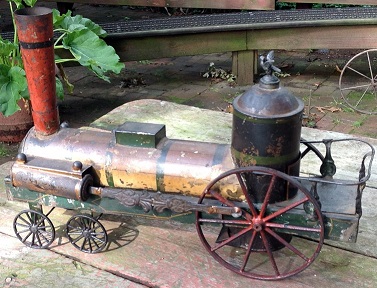By Marty Maloy

A bit of historical background is in order for full appreciation of this extremely rare find, an early American-style toy locomotive found quite dirty on a mantle in Philadelphia where she sat for many years.
England was responsible for all the major developments in early steam locomotives. Consequently, America imported its first locomotives in the 1830s from Britain (usually the rigid 0-4-0 types). The British railways at that time enjoyed some major advantages over ours: they were sufficiently financed, covered shorter distances, had superior track, and carried more passengers and freight. Conversely, the United States was a poor and wild country—with inexpensive track stretched to its limits by necessity—which in turn caused the imported British locomotives to frequently derail. This led to the development in the US of locomotives with better tracking thanks to the addition of an “equalized” front truck and two large driving wheels. This development occurred around 1840. For the next 10 years or so, many of these 2-4-0 types were constructed.
The “Brother Jonathan” is an excellent early example of an engine that is similar in appearance to our toy. A tome by John H. White, Jr. (Smithsonian Curator of Transportation) titled A History of the American Locomotive discusses development during the period 1830-1880.
Note the following on our toy: no cab, no cowcatcher, a wood-burning-style firebox, a wood-lagged boiler (paint simulated), tall smokestack, and early-type sandbox—all in all, a rather to-scale-like appearance.
The shape of the connecting rod is a strong clue to the maker—highly probably, Francis Field—and that it is possibly a one-off for his son, or so I fantasize. It is 18 inches long without its tender. This toy was possibly made about 1840, which would make it the earliest American tin toy locomotive that I know of.
Restoration consisted mainly of a very lengthy clean up and some very minor touch-up by Mark Olympio—who sent me an email photo of a box with about 1,000 dirty Q-tips in it. I promptly sent him a new box. Thank goodness the original paint was intact and revealed the live and true colors of this most beautiful toy.
PS: Baldwin (Philadelphia) made many 2-4-0-type engines. Field may have copied one of their originals.
